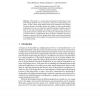Free Online Productivity Tools
i2Speak
i2Symbol
i2OCR
iTex2Img
iWeb2Print
iWeb2Shot
i2Type
iPdf2Split
iPdf2Merge
i2Bopomofo
i2Arabic
i2Style
i2Image
i2PDF
iLatex2Rtf
Sci2ools
PUK
2001
2001
A perspective based approach to design
Urban design is a creative task that demands the balancing of issues from multiple domains such as architecture, zoning laws, traffic planning, and others. As such, classic design models based on the assumption of the designer wandering through a monolithic design space guided by largely predetermined requirements turn out not to hold here, instead the designer constantly alters his point of view and will frequently re-evaluate his precepts to arrive at better or even simply innovative solutions. We are working on a formalization of this state of affairs. Instead of a global design space, the design is described in terms of perspectives between which the designer shifts during work. Design knowledge is incorporated both in the description of the perspectives and the translations that occur between them.
| Added | 31 Oct 2010 |
| Updated | 31 Oct 2010 |
| Type | Conference |
| Year | 2001 |
| Where | PUK |
| Authors | Oliver Hoffmann, Markus Stumptner, Talik Chalabi |
Comments (0)

